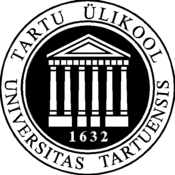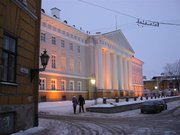University of Tartu
|
|
| University of Tartu | |
|---|---|

| |
| Data | |
| Estonian | Tartu Ülikool |
| Latin | Universitas Tartuensis |
| Established | 1632 |
| Location | Tartu, Estonia (EU) |
| Enrolment | circa 18,500 |
| Rector | Prof. Jaak Aaviksoo |
| Address | Ülikooli 18 50090 Tartu Estonia |
| Phone | +372-737-5100 |
| proffice@ut.ee | |
| Homepage | http://www.ut.ee |
| Membership | EUA, Coimbra Group |
| Map | |
 Tartu in Estonia | |
The University of Tartu (Estonian: Tartu Ülikool, German: Universität Dorpat) is the national university of Estonia, and the one classical university in Estonia, located in the city of Tartu. The university is a member of the Coimbra Group and was established by King Gustav II Adolph of Sweden in 1632.
At different times during its hitory the University of Tartu was known as Academia Gustaviana, University of Dorpat, (Kaiserliche) Universität (zu) Dorpat, and University of Yuryev/Jurjev.
| Contents |
History
Founded by the Swedes as part of their colonial policy in just-conquered Livonia, the Academia Gustaviana was the second university founded in Swedish-ruled territory, following Uppsala University. A precursor to the academy had been a Jesuit grammar school, existing between 1583 and 1601, when Tartu (Dorpat) was under Polish rule. Struggling until 1710 and being removed to Pärnu in the end, the university was refounded in 1802 by order of the at that time reform-minded Emperor Alexander I, of Russia to which Livonia then belonged.
The language of instruction at Dorpat was German between 1802 and 1893. During that time, Dorpat had a dual nature in that it belonged both to the set of German(-language) and Russian universities. Financially and administratively, the latter was more important; intellectually and regarding the professoriate, the former (over half the professors came from Germany, another third at least were German Balts). In fact, among the 30 German-language universities, of which 23 were inside the German Empire, Dorpat was the 11th in size. In teaching, the university educated the local Baltic-German leadership and professional classes as well as staff especially for the administration and health system of the entire Russian Empire. In scholarship, it was an international university; the time between 1860 and 1880 was its "golden age".
The freedom to be a half-German university ceased with the rise of nationalist tendencies in Russia, which held homogenization more important than retaining one university at the international level within the Empire. Between 1882 and 1898, Russification in language, appointments, etc., was imposed, with some exceptions (such as the Divinity School, which was feared to teach dangerous Protestant views by the Orthodox clergy and thus was allowed to continue in German until 1916). In 1898, the university was renamed Jurjev; by then, virtually all distinguished scholars from Germany had left. The University of Juryev existed until 1918, when during part of the Fall Term, it was reopened, under German occupation, as Dorpat. Russian academic staff and students took refuge in Voronezh in Russia, giving rise to the foundation of Voronezh State University, which traces its own history back to the foundation of the University of Tartu and still holds several physical properties of the latter.
In 1919, the University of Tartu was established as an Estonian institution; it stayed open until 1940. In 1940, it became Soviet, and 1941-44, it was again under German occupation and again called Dorpat. Since 1944, it has been the University of Tartu (1940-1941 and 1944-1989 "Tartu State University"). During the second period of Russian (Soviet) occupation (1944-1991), Estonian was the principal language of instruction, although some courses were taught in Russian, and there were several Russian curricula. To a lesser degree, this is still true today, after regaining of Estonian national independence. The full recovery of academic autonomy of the University can be dated to 1992.
The history of the last decade has been marked by organizational and structural changes, as well as adaptions to various university models (American, Scandinavian, German) against the background of the Soviet and Baltic German past. Most recently and still currently, the University is marked by the peculiar adaption of the Bologna declaration in Estonia generally and Tartu specifically, leading to major changes in curricula and studies, as well as by strong organizational centralization attempts.
Buildings
The University’s four museums, its Botanical Gardens, and sports facilities are, by and large, open to the general public. The University possesses some 150 buildings, 30 of which are outside of Tartu. 31 of its buildings decorate the city as architectural monuments. At the same time, there are numerous recently constructed/renovated university buildings and student dormitories.
Research
At the University of Tartu, more than 3,300 publications are produced every year. About half of all publications by Estonian scientists in journals (those covered by citation indexes like "SCI Expanded", "SSCI" or "A&HCI") are written by Tartu authors.
According to the university itself, the most remarkable recent research achievements have been in the fields of molecular and cell biology, gene technology, immunology, pharmacology, laser medicine, materials science, laser spectroscopy, biochemistry, environment technology, computer linguistics, psychology, and semiotics.
The university has begun to cooperate with private enterprises, and has started to be the nucleus of the development of spin-off firms.
Faculty and Alumni
Notable Lecturers & Professors
Nobel laureate
Humanities and Social Sciences
- Jüri Allik, psychologist
- Walter Anderson, folklorist
- Karl Bücher, economist and anthropologist
- Vladimir Dahl, lexicographer
- Wolfgang Drechsler, public administration scholar and political philosopher
- Gustav von Ewers, legal historian
- Lazar Gulkowitsch, Jewish Studies scholar, supported by Albert Einstein
- Theodosius Harnack, Lutheran theologian
- Siim Kallas, economist and politician (EU Commissioner; former Prime Minister)
- Emil Kraepelin, psychologist
- Jaan Kross, writer
- Etienne Laspeyres, economist and statistician
- Wilhelm Lexis, economist, insurance scholar
- Yuri Lotman, semiotician
- Alexander von Oettingen, Lutheran theologian, famous as statistics theoretician
- Ludwig Preller, philologist and antiquarian
- Rein Taagepera, political scientist
- Grigol Tsereteli, classicist and papyrologist
- Adolph Wagner, economist and social policy scholar
Natural Science
- Jaan Einasto, astrophysicist
- Johann Friedrich von Eschscholtz, biologist and explorer
- Germain Henri Hess, chemist
- Matthias Jakob Schleiden, botanist
- Friedrich Georg Wilhelm Struve, astronomer
Notable Students
- Karl Ernst von Baer, zoologist and "father" of embryology
- Anton Hansen Tammsaare, eminent Estonian writer
- Adolf von Harnack, Protestant theologian and science administrator
- Nicolai Hartmann, philosopher
- Paul Keres, chess player
- Alberts Kviesis, Latvian statesman
- Heinrich Friedrich Emil Lenz, physicist
- Lennart Meri, Estonian politician
- Leo Michelson, painter
- Juhan Parts, one-time Prime Minister of Estonia (Res Publica)
- Grigol Robakidze, Georgian writer
- Leopold von Schrenck (1826-1894), zoologist, geographer and ethnographer
- Otto Strandman, former Estonian Prime Minister and Head of State
- Valentin Tomberg, "mystic" and "magician"
Honorary Doctorates
- Umberto Eco, semiotician and novelist
- Otto Kaiser, Protestant theologian
- Arvo Pärt, classical composer
- Tenzin Gyatso, 14th Dalai Lama
Academic co-operation
The University has signed cooperation agreements with 30 universities and research institutions abroad, and 140 contracts for international student and teacher exchange projects within the framework of the EU's "Erasmus programme".
At present, nearly 400 foreign exchange students from 27 countries study at the University. The vast majority comes from Finland, Sweden, Latvia, Russia, the United States of America, and Germany.
The University of Tartu has co-operation agreements with the following universities at the time. These cooperation agreements can include student exchange programmes.
European Union
- University of Amsterdam, Amsterdam, Netherlands
- University of Giessen, Giessen, Germany
- University of Gothenburg, Gothenburg, Sweden
- University of Granada, Spain
- Georg August University of Göttingen, Göttingen, Germany
- Ernst Moritz Arndt University of Greifswald, Greifswald, Germany
- University of Hamburg, Hamburg, Germany
- University of Helsinki, Helsinki, Finland
- University of Latvia, Riga, Latvia
- University of Leuven, Leuven, Belgium
- Lund University, Lund, Sweden
- University of Maastricht, Maastricht, Netherlands
- University of Marburg, Marburg, Germany
- University of Münster, Münster, Germany
- University of Turku, Turku, Finland
- Uppsala University, Uppsala, Sweden
- Vaasa University, Vaasa, Finland
- University of Vilnius, Vilnius, Lithuania
Others
- University of Toronto, Toronto, Canada
- Waseda University, Japan
- University of Saint Petersburg, Saint Petersburg, Russia
- University of Georgia, USA
- University of North Carolina, Greensboro, USA
Bibliography
- Alma Mater Tartuensis (1632-1982) (1982). Tullio Ilomets and Hillar Palamets, eds. Tallinn: Eesti Raamat.
- Engelhardt, Roderich von (1933). Die deutsche Universität Dorpat in ihrer geistesgeschichtlichen Bedeutung. München: Ernst Reinhardt.
- Mägi, Reet and Wolfgang Drechsler, eds. (2004). Kaiserliche Universität Dorpat 200 – Academia Gustaviana 370 – The Jubilee of the University of Tartu. Tartu: Tartu University Press.
- Semel, Hugo, ed. (1918). Die Universität Dorpat (1802-1918). Dorpat: Laakmann.
See also:
External links
- University of Tartu (http://www.ut.ee/index.aw/set_lang_id=2)
- University of Tartu - Pärnu College (http://www.pc.ut.ee/default.php?1)
- Tartu University Hospital (http://www.cut.ee/eng/)
- Tartu Student Village (http://www.kyla.ee/eng/)
- Tartu University Library (http://www.utlib.ee/)
- City of Tartu (http://www.tartu.ee)
- Coimbra Group (http://www.coimbra-group.be) (a network of European research universities)
| Coimbra Group (of European research universities) | 
|
|---|---|
| Aarhus | Barcelona | Bergen | Bologna | Bristol | Budapest | Cambridge | Coimbra | Dublin | Edinburgh | Galway | Geneva | Göttingen | Granada | Graz | Groningen | Heidelberg | Jena | Kraków | Leiden | Leuven | Louvain | Lyon | Montpellier | Oxford | Padua | Pavia | Poitiers | Prague | Salamanca | Siena | Tartu | Thessaloniki | Turku I | Turku II | Uppsala | Würzburg | |
et:Tartu Ülikool fr:Université de Tartu ro:Universitatea din Tartu

